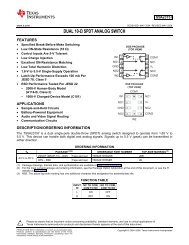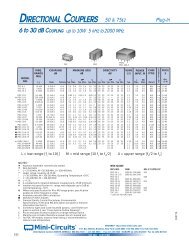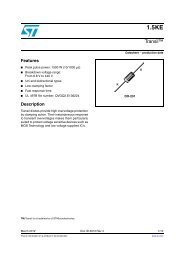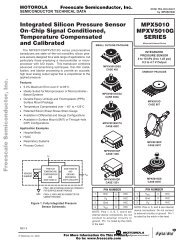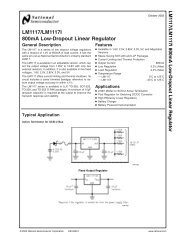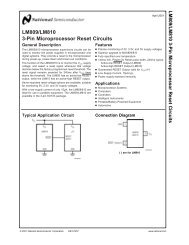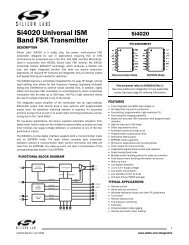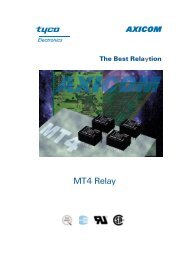LM3445 Triac Dimmable Offline LED Driver
LM3445 Triac Dimmable Offline LED Driver
LM3445 Triac Dimmable Offline LED Driver
Create successful ePaper yourself
Turn your PDF publications into a flip-book with our unique Google optimized e-Paper software.
<strong>LM3445</strong><br />
Application Information<br />
FUNCTIONAL DESCRIPTION<br />
The <strong>LM3445</strong> contains all the necessary circuitry to build a linepowered<br />
(mains powered) constant current <strong>LED</strong> driver whose<br />
output current can be controlled with a conventional triac dimmer.<br />
OVERVIEW OF PHASE CONTROL DIMMING<br />
A basic "phase controlled" triac dimmer circuit is shown in<br />
Figure 2.<br />
30060312<br />
FIGURE 2. Basic <strong>Triac</strong> Dimmer<br />
An RC network consisting of R1, R2, and C1 delay the turn<br />
on of the triac until the voltage on C1 reaches the trigger voltage<br />
of the diac. Increasing the resistance of the potentiometer<br />
(wiper moving downward) increases the turn-on delay which<br />
decreases the on-time or "conduction angle" of the triac (θ).<br />
This reduces the average power delivered to the load. Voltage<br />
waveforms for a simple triac dimmer are shown in Figure 3.<br />
Figure 3a shows the full sinusoid of the input voltage. Even<br />
when set to full brightness, few dimmers will provide 100%<br />
on-time, i.e., the full sinusoid.<br />
FIGURE 3. Line Voltage and Dimming Waveforms<br />
30060313<br />
Figure 3b shows a theoretical waveform from a dimmer. The<br />
on-time is often referred to as the "conduction angle" and may<br />
be stated in degrees or radians. The off-time represents the<br />
delay caused by the RC circuit feeding the triac. The off-time<br />
be referred to as the "firing angle" and is simply 180° - θ.<br />
Figure 3c shows a waveform from a so-called reverse phase<br />
dimmer, sometimes referred to as an electronic dimmer.<br />
These typically are more expensive, microcontroller based<br />
dimmers that use switching elements other than triacs. Note<br />
that the conduction starts from the zero-crossing, and terminates<br />
some time later. This method of control reduces the<br />
noise spike at the transition.<br />
Since the <strong>LM3445</strong> has been designed to assess the relative<br />
on-time and control the <strong>LED</strong> current accordingly, most phasecontrol<br />
dimmers, both forward and reverse phase, may be<br />
used with success.<br />
www.national.com 8



